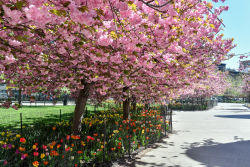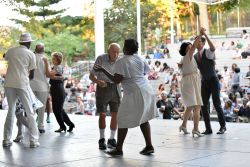Marcus Garvey Park
Manhattan Schist in New York City Parks
Schist—which can be seen in Morningside Park, Marcus Garvey Memorial Park, and J Hood Wright Park—is an extremely strong and durable rock type. Deep below the buildings and busy streets of New York City, beneath the labyrinth of subway tunnels and stations, lies the geologic foundation that makes New York City unique in the world. This foundation consists of the city’s five bedrock layers: Fordham gneiss, found primarily in the Bronx; Manhattan schist, in Lower and northern Manhattan; the Hartland Formation, in central Manhattan, the Bronx, Brooklyn, and Queens; Staten Island serpentinite, in Staten Island; and Inwood marble, in Manhattan and beneath the rivers that surround it. But it is Manhattan schist, the most prevalent bedrock in Manhattan, that makes the city’s famed skyline possible.
Manhattan schist was formed about 450 million years ago, making it the second oldest of New York City’s bedrocks, after Fordham gneiss. At that time, the continents of the world existed as a single supercontinent, called Pangea. The continents and oceans are not anchored down in a fixed position—they rest on landmasses called tectonic plates, which float on the earth’s molten core. The plates shift continuously, colliding and separating, causing earthquakes and volcanic eruptions and forming jagged mountain ranges.
A continental collision between what is now the East Coast of North America and the floor of the Atlantic Ocean pushed a layer of shale–a sedimentary rock composed of clay and sand–roughly nine miles into the molten core of the earth. There, the intense heat and pressure transformed the shale into a conglomeration of minerals, including quartz, feldspar, hornblende, and mica. The resulting metamorphic rock is known as schist. Subsequent continental shifts pushed the schist back to the surface. In some areas the schist has even been exposed. The massive rock formation that rises out of Morningside Park is a visible sign of the Manhattan schist bedrock below. Schist can be recognized by its glittering appearance, which is caused by flecks of white mica within the rock.
Manhattan schist is found at various depths – from 18 feet below the surface in Times Square to 260 feet below in Greenwich Village. Where bedrock is far below the surface, skyscrapers are not practical because it is too difficult to reach the schist that provides structural stability and support. Consequently, there are few tall buildings in Greenwich Village, but skyscrapers stand in dense clusters in midtown where schist lies close to the surface. The schist formations display a rock whose importance cannot be overestimated—New York City reaches its towering heights because of this strong foundation.
Check out your park's Vital Signs
Clean & Safe
Green & Resilient
Empowered & Engaged Users
Share your feedback or learn more about how this park is part of a
Vital Park System










